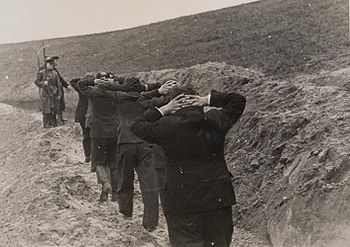Himmler’s willing executioners. This was the beginning of nightmare in occupied Poland

Poles were murdered by Selbstschutz members, German citizens of pre-war Poland
PIOTR WŁOCZYK: The reason given for creation of Selbstschutz, a vicious paramilitary organization of Polish citizens of German origin, was self-defence against the Poles. How much of self-defence was there in its operations?
JOCHEN BÖHLER: In the first days of German attachment of Poland we could still speak in this context – to an extent – about a psychological need for self-defence. Polish citizens of German origin unavoidably at the beginning of the conflict felt threatened by their Polish neighbours, policemen and Polish Army soldiers retreating through cities and towns.
However, from the very beginning – from September 1939 – Selbstschutz became an element of the Third Reich’s terror machine that had nothing to do with self-defence. Self-defence was mere propaganda. Volksdeutsche were members of squadrons of death – because this is what Selbstschutz’s activity in fact boiled down to. They helped Einsatzgruppen murder Polish intelligentsia already in the first days of the war.
Who was behind the establishment of those squadrons of death?
At the beginning, “self-defence” groups were created spontaneously, but already in the first days of September Selbstschutz became a part of the SS. Heinrich Himmler would not allow this “self-defence” to operate other than under his control, so he established Volksdeutscher Selbstschutz.
Himmler saw the potential of the formation. Those people had an excellent local knowledge of the areas that were to be annexed to the Third Reich. Already as children they learnt who was who in their towns and cities. They were able to single out Polish intelligentsia, identify people who would pose a threat to German domination, who could inspire Poles to fight.
The main task of Selbstschutz was to murder Polish intellectuals and leaders in areas annexed to the Third Reich. We must remember that in addition to identifying members of the Polish elite, Selbstschutz was also to help Einsatzgruppen in carrying out this task.
The decision to exterminate Polish elites was made even before the attack on Poland. In July 1939 Himmler met with Einsatzgruppen commanders and was clear that the objective would be to cut the “head” of the Polish society. Without help of Volksdeutsche from Poland, Einsatzgruppen would have a much more difficult task – it would be more difficult for them to understand the local situation.
Selbstschutz operated on parts of Poland annexed to the Third Reich, that is, in western and north-western Poland. Those areas were to be completely “purged” of Poles and Jews, who were to be murdered as soon as possible. After all, it was not clear what the next months would bring – France was a great threat, therefore, Himmler wanted to get rid permanently of Poles and Jews from the annexed areas.
In your book “The 1939 Invasion” you mentioned the abominable role of Ludolf von Alvensleben, who was responsible for incorporating Selbstschutz into the SS structures. Poles should remember that name.
Alvensleben was a fanatic NSDAP member, Himmler’s aide. The year 1939 was a great opportunity for him to boost his career. When he was assigned with the task of building the Selbstschutz, he fully committed himself to it. His radicalism spread to the bottom because he chose people who were similar to him and demanded full devotion to the Nazi ideology. After the war he escaped to South America and regrettably never answered for his crimes in court.
For how many victims was Selbstschutz responsible?
By the end of 1939 Selbstschutz death squadrons with two operational groups of the Security Police murdered altogether over 40 thousand people, of which 30 thousand victims were killed in the Gdansk-West Prussia District (Reichsgau), 10 thousand – in Reichsagu Wartherland, 1.5 thousand in Upper Silesia District and one thousand in Regierungsbezirk Zichenau. In the General Governorate, approximately five thousand people were executed. Also by the end of the year, in the occupied Poland at least 7 thousand Jews were killed, and the main role was played by the Security Police and Security Service.
Unfortunately, we cannot be completely certain as to the number of victims because Germans took a lot of efforts to destroy any evidence of their crimes. In my opinion, Selbstschutz is responsible for at least 40 thousand victims.
The fact that it was prohibited to record instructions given to Selbstschutz from their SS commanders must definitely make it more difficult for historian to reach the truth.
That’s right. At the beginning of the extermination the Germans were afraid of the consequences. They did not want to document it, were afraid of stating anything in documents. Einsatzgruppen regularly sent reports on their activity to Berlin, but the exact number of victims was not given. After the outbreak of the German-Soviet war the situation changed dramatically. The same Einsatzgruppen started to boast about numbers, it almost gives an impression of different squads competing as regards statistical data.
Before the war there were approximately 750 thousand Germans in Poland. How many members did Selbstschutz have?
German historians estimate that at the peak of Selbstschutz’s murderous activity, at the end of November 1939, it had 40 thousand members.
So more or less every tenth Polish citizen (man) of German origin was a member of that genocidal organization.
Proportionally this is indeed a very large number. Most Selbstschutz members were 25–35 years. One-third of Selbstschutz members had higher education! So you cannot say that these were “simple folk”, not aware of what they were doing. Though of course they were fed Nazi propaganda, which reached its apogee in the summer of 1939, highly radicalizing the German communities in pre-war Poland.
Not all of them were disloyal towards the Polish state, but we know that a large part of the German minority actually acted as the fifth column in Poland. Maybe it was not such a big group as later presented by the communist Poland’s propaganda, but did pose a serious challenge to the country. I suppose that the German propaganda after September 1939 had a greater influence on the radicalisation of Selbstschutz members that what its members could hear from Goebbels earlier. I am mainly referring to approximately 300 Germans killed by Poles in Bydgoszcz and how the German propaganda presented those killings.
Selbstschutz in Poland should be associated with its most atrocious crime, that is, Piaśnica massacre, known as “Kashubian Golgotha”.
Unfortunately, the Germans are completely unaware of this crime. Over ten thousand people were murdered there, or maybe even fourteen thousand. People in Kashubia remember the massacre. The question is, to what extent it is known in Poland?
The victims were primarily intellectuals and community leaders from pre-war Poland. Most of them were Poles but also many Jews were killed. They were not murdered because of anti-Semitism. They were simply considered as part of Polish intelligentsia – it is well known that among Polish Jews there were many lawyers, doctors… Also many handicapped and mentally ill persons were killed.
Also Poles who before September 1939 lived in the Third Reich were brought to Piaśnica Woods and murdered there.
You wrote in your book: “[…] savage mass arrests and executions in the autumn of 1939 sometimes by mistake involved representatives of the German minority”. How is it possible that the methodical – it would seem – German extermination policy could allow such mistakes?
It is known that after 20 years of living in pre-war Poland, differences between Poles and German would blur. In many cases it was hard to determine at first glance who is a 100-percent German. Selbstschutz’s savagery was so great that in some instances indeed German nationals, who did not speak German fluently and had a problem with proving their origin, were murdered. If instances of killing Volksdeutsche or robbing them were discovered, German authorities would intervene because it was not the “German way” to spill native blood. In some cases Selbstschutz members were held responsible.
To what extent looting or revenge provided motivation for Selbstschutz members?
This is a very important aspect. Selbstschutz activity was in fact conducted as a carte blanche. Many times the members would use it as an opportunity to get even with their Polish neighbours, it was also a good pretext for robbing them or for raping women. And that was strictly criminal activity.
You have mentioned that the killing by Poles of approximately 300 Germans in Bydgoszcz gave the German propaganda a perfect reason to launch a campaign of fear. Could this crime serve as an explanation for later mass murders by Selbstschutz?
Absolutely not! However, Einsatzgruppe IV members after entering Bydgoszcz must have been stricken and therefore radicalized by seeing dead Germans laying on the streets. The commander of that unit, over dead bodies of the murdered people, was convincing his subordinates that this was why they had to fight most brutally with Poles. And indeed, in the next days, in Bydgoszcz area the Germans took an atrocious revenge.
The “bloody Sunday” in Bydgoszcz was without question a great gift to the German propaganda, which spoke about a higher and higher numbers of killed Germans. At first, the number of Volksdeutsche killed by Poles was estimated at five thousand, but within a year it went up to 60 thousand. Of course, this was a lie.
I would like to emphasize an important issue: we should not try to find a causality between Polish crimes against Germans in September 1939 and mass murders by Selbstschutz. The systematic, planned extermination of Polish intellectuals and leaders cannot be justified by crimes perpetrated by Poles. To some extent they probably aggravated the radicalism but – as I already mentioned – the decision to murder Polish intelligentsia was made before September 1939.
Today there is not much doubt that the number of pre-war Poland’s citizens of German origin who were killed in September 1939 is approximately 4.5 thousand.
That’s right, this number is generally accepted by Polish and German historians. However, we have to bear in mind that among 4.5 thousand victims there were people killed in militarily actions, by German bombs and bullets. They did not differentiate between Polish and German homes.
What do you, as a German historian, think about the manner in which Poland treated its citizens of German origin in September 1939? Some even refer to the marching of thousands of arrested Germans expelled to the East of Poland as the “marches of death”.
There is one big difference between the German and Polish authorities – the Poles did not intend to murder people. But the Germans from day one were methodically implementing an extermination program.
Polish policemen and soldiers arrested some Germans considered to be a threat to Poland and marched them to the East because of problems with means of transport. But this was an ad hoc action, taken in response to the German attack. There was a real threat that those people would be very loyal towards Berlin and would disrupt Polish defence efforts. I think that victims of those marches were caused by war chaos and not intentional actions.
The circumstances of Selbstschutz dismantling , in the early 1940, seem to be a pure irony of fate, do they not?
In the eyes of Poles the German minority after 1 September 1939 was a part of the occupation forces. Yet paradoxically, in the eyes of Himmler, that is – in his view – of a pure German from the Reich, Polish Germans were not trustworthy. They were considered to be half-Poles. After fulfilling their objective, that is, helping to murder Polish intellectuals and leaders in parts of Poland annexed to the Third Reich, Himmler decided to dissolve Selbstschutz. Its members were allocated to different SS units, and some went back home. German authorities considered Selbstschutz as a formation at the lowest level of the terror machine.
Maybe this will be interesting to the readers: Do you how many Selbstschutz members were convicted in the German Federal Republic for participation in crimes?
As I understand, very few?
Dieter Schenk, a German criminologist, who investigated German crimes after the war, determined that it was possible to identify 1.7 thousand Selbstschutz veterans in the German Federal Republic. The prosecution initiated investigations against 258. 233 investigations were quashed. Eventually, 10 persons were convicted in GFR… Thus, the law enforcement system in West German convicted fewer Volksdeutsche for crimes during the September campaign than Nazi courts in the years 1939–1940.
Dr. Jochen Böhler is a German historian and academic at the Friedrich Schiller University in Jena; he is an expert on German occupation of Poland. In the years 2000–2010, Dr. Böhler worked at the German Historical institution in Warsaw. He is the author of the book “1939 Invasion” describing Hitler’s invasion of Poland.
This interview was published in 2016 in “Do Rzeczy” magazine.



